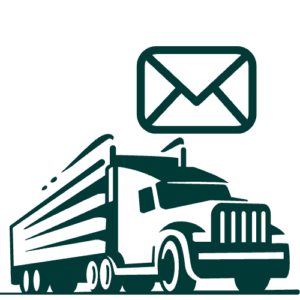If you spend time on trucking load boards, you’ll run into some curious industry terms: hot loads, hot shot loads, and expedited freight. All these bits of jargon are related, and you’ll often find them used interchangeably. In fact, there are subtle differences between all three—and none of them have to do with temperature.
Understanding this industry language can help you choose jobs that provide the most profit for the time and money you put into your business. So here are answers to questions that make a real bottom-line difference for truckers, starting with the most common: What is a hot load in trucking?
What does “hot load” mean in trucking?
A hot load is time-sensitive freight. These loads might be past due. They might be perishable and past due. They might even be tied to fines or penalties for the brokers who promised to get them from point A to point B by a certain deadline—one that’s fast approaching or just passed. Sometimes a customer orders an expedited delivery, and it’s up to the shipper to find a carrier who can meet that goal. That’s when they hop on the load board and advertise a hot load.
Long story short: The “hot load” trucking term means urgency. This freight has to move now. Shippers and brokers are often willing to pay above market rate for that immediacy. But a hot load may be the exact same freight you carry on a day-to-day basis. A hot shot load is a little bit different, and requires a little bit more specialization from trucking companies.
What is a hot shot load in the trucking industry?
We brought up load boards earlier. These online marketplaces match shippers and brokers with carriers, and DAT is one of the top load boards in the industry, with dedicated lists of hot shot jobs for specialist carriers. So we’ll defer to DAT’s definition of a hot shot load:
| Hot Shot Loads According to DAT |
| “Hot shot loads are time-sensitive freight that can be delivered with smaller trucks and trailers to easily accessible locations.” |
Hot shot trucking is often associated with the oil and gas industry. Oil fields need drill bits and other heavy equipment, and they need them fast. They may be far from the highway. So an entire cottage industry of hot shot carriers armed with dual rear-wheel (DRW) trucks—more commonly known as duallys—and gooseneck trailers arose to meet the need.
That’s not to say that hot shot drivers only serve the oil fields; just that they’re a driving force in the growth of the hot shot subsection of the trucking industry.
What counts as expedited freight?
Both hot loads and hot shot loads are collectively referred to as “expedited freight.” That’s just what it sounds like: It’s a delivery that needs to move faster than normal. Expedited freight is a broader term than either “hot load” or “hot shot” load, but it carries the same advantage for trucking companies: Shippers and brokers are willing to pay more to expedite delivery.
What equipment do you need to handle hot loads, hot shot loads, and expedited freight?
From the trucking company’s perspective, the key difference between a “hot load” or general expedited freight and the more specialized “hot shot” load is one of equipment.
Hot shot loads move on smaller trucks and trailers. That makes hot shot trucking an excellent option for getting into the trucking industry. If you have a dually and a gooseneck, you can pick up hot shot loads on the weekend. Running a hot shot trucking company requires less capital than a full-on over-the-road freight operation.
If you’re already in business as an owner-operator or a fleet owner, you can choose hot load jobs that match your trucks and trailers. If you just have a dually or even a box truck, you can get into hot shot trucking without needing a fleet of full-length trailers. But there are trade-offs to taking expedited freight that may or may not make it a smart business choice.
Are hot loads profitable for trucking businesses?
It’s tempting to offer an unqualified “yes,” because shippers and brokers pay more for expedited freight. But the truth is that it will depend on your business.
An ongoing freight contract with a reliable shipper may be worth more in the long run than a few hot load jobs—and to take expedited freight, you often have to keep your trucks free, gambling that a suitable hot load will show up on the load boards.
Many carriers only handle hot shot loads. As we mentioned, that’s particularly common in the oil industry. For these businesses, hot shots are the only game in town. But for fleet owners who work along dedicated routes, the question of whether to take hot loads will change from job to job. They might be a great way to remove a few deadhead miles (those unprofitable trips where you’re just moving the rig, not a paying load of freight). Letting your truck idle while you hope for a hot load to arrive, however, isn’t usually the best strategy.
Where do you find hot loads and hot shot loads?
Two words: load boards.
An established online trucking marketplace like DAT lets carriers filter jobs by type. You can look for hot shot loads based on your vehicles and trailers, zeroing in on jobs for goosenecks, flatbeds, box trucks, and more. If you’re running a conventional less-than-load (LTL) job along your lane, you might find an expedited LTL hot job to fill the rest of the trailer—and boost profits along the way. Get on a load board and check it to find expedited freight opportunities whenever you need a little boost to your business.
How long do hot loads take to pay?
Expedited freight doesn’t necessarily come with expedited payment. Shippers and brokers famously operate on lengthy payment terms: 30 days and even 60 days are the norm. That can create cash flow problems, especially for brand-new hot shot carriers who enter the industry without a lot of capital. And in an industry that literally runs on fuel, cash flow is an essential precondition for staying in business.
Can you get hot load invoices paid faster?
Yes. As we’ve seen with the growth of hot shot carriers, the trucking industry is great at coming up with solutions to fill holes in the supply chain. That’s also true for trucking company financing. The answer to your cash flow problems is an industry-specific financial service called factoring.
Factoring companies pay your invoices quickly, often within a day or two, then collect from the shippers and brokers who hired you later on. They charge a small percentage fee for the service, but factoring is an essential cash-flow tool, especially when you’re first getting your business up and running.
There’s no easier—or more affordable—way to factor trucking invoices than Bobtail. This no-contract factoring tool removes the hidden fees, restrictive contracts, and volume requirements that make many factoring services more trouble than they’re worth. You simply open the app, upload a bill of lading and rate confirmation, and get paid the same day (or the next day if it’s after 11 a.m.) Rates are as low as 1.99% of the invoice value—and you choose which invoices to factor, leaving at any time. That’s the value of a no-contract factoring with Bobtail. Learn more about the risks of factoring contracts.
Now that you know what a hot load in trucking is, you can start reaping the benefits—and with factoring from Bobtail, you won’t have to wait for payments to start rolling in.
Try Bobtail by signing up here.

Article By
Keep Learning







